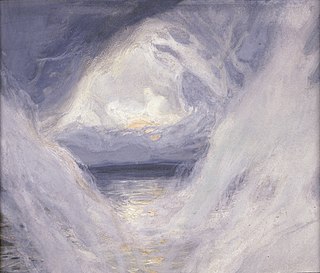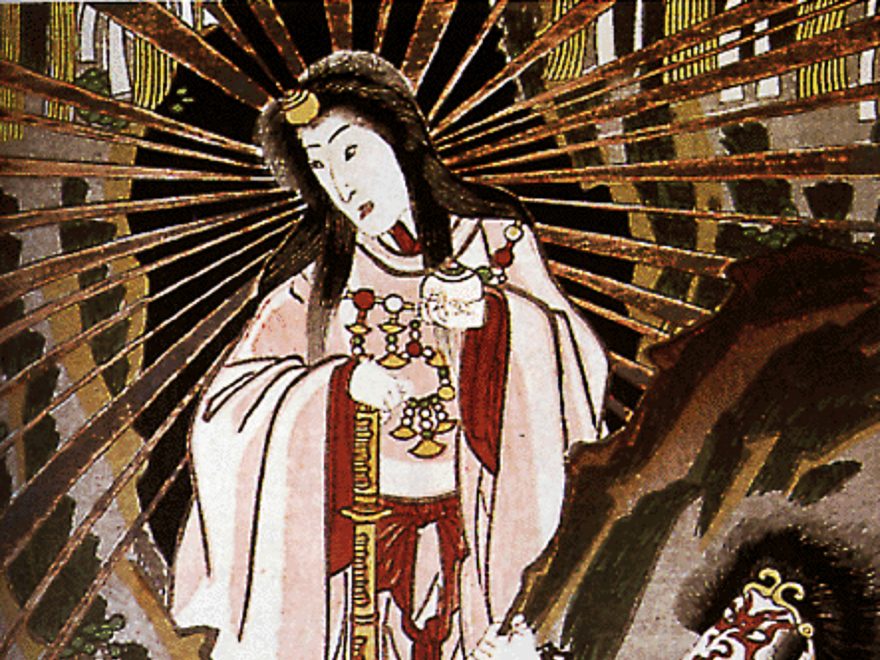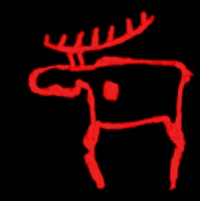The Kaluli creation myth is a traditional creation myth of the Kaluli people of Papua New Guinea. In the version as was recorded by anthropologist and ethnographer Edward L. Shieffelin whose first contact with them took place in the late 1960s. The story begins in a time the Kaluli call hena madaliaki, which translates "when the land came into form." During the time of hena madaliaki people covered the earth but there was nothing else: no trees or plants, no animals, and no streams. With nothing to use for food or shelter, the people became cold and hungry. Then one man among them (alternative accounts give two) gathered everyone together and delegated different tasks. He directed one group to become trees and they did. He directed another to become sago, yet another to be fish, another banana and so forth until the world was brimming with animals, food, streams, mountains and all other natural features. There were only a few people left and they became the ancestors of present-day human beings. [1] [2]
The Kaluli describe this story as "the time when everything alə bano ane" which means roughly "the time when everything divided". This concept of all world phenomena as a result of a "splitting" has many echos in Kaluli thought and cultural practices. In the Kaluli world view, all of existence is made from people who differentiated into different forms. Animals, plants, streams and people are all the same except in the form they have assumed following this great split. Death is another splitting. The Kaluli have no concept of a transcendent, sacred domain that is spiritual or in any fundamental way distinct from the natural, material world; instead death is another event that divides beings through the acquisition of new forms which are unrecognizable to the living. [1] [2]
The Kaluli are an indigenous people whose first contact with contemporary western civilization began in the 1940s. Following extensive Christian missionary efforts in the region, variants of the traditional creation story have adopted a few Christian elements. Prior to contact, the Kaluli story described creation as a pragmatic solution to problems of cold and hunger, and the efforts were initiated by one or two ordinary and unnamed men rather than any deity or deities. The Kaluli have since tended to identify one or both of them as "Godeyo" (God) and "Yesu" (Jesus Christ). [1] [2]

A creation myth is a symbolic narrative of how the world began and how people first came to inhabit it. While in popular usage the term myth often refers to false or fanciful stories, members of cultures often ascribe varying degrees of truth to their creation myths. In the society in which it is told, a creation myth is usually regarded as conveying profound truths – metaphorically, symbolically, historically, or literally. They are commonly, although not always, considered cosmogonical myths – that is, they describe the ordering of the cosmos from a state of chaos or amorphousness.
Religion and mythology differ in scope but have overlapping aspects. Both terms refer to systems of concepts that are of high importance to a certain community, making statements concerning the supernatural or sacred. Generally, mythology is considered one component or aspect of religion. Religion is the broader term: besides mythological aspects, it includes aspects of ritual, morality, theology, and mystical experience. A given mythology is almost always associated with a certain religion such as Greek mythology with Ancient Greek religion. Disconnected from its religious system, a myth may lose its immediate relevance to the community and evolve—away from sacred importance—into a legend or folktale.
A creator deity or creator god is a deity or god responsible for the creation of the Earth, world, and universe in human religion and mythology. In monotheism, the single God is often also the creator. A number of monolatristic traditions separate a secondary creator from a primary transcendent being, identified as a primary creator.

Mesopotamian religion refers to the religious beliefs and practices of the civilizations of ancient Mesopotamia, particularly Sumer, Akkad, Assyria and Babylonia between circa 3500 BC and 400 AD, after which they largely gave way to Syriac Christianity practiced by today's Assyrians. The religious development of Mesopotamia and Mesopotamian culture in general, especially in the south, was not particularly influenced by the movements of the various peoples into and throughout the area. Rather, Mesopotamian religion was a consistent and coherent tradition which adapted to the internal needs of its adherents over millennia of development.
Latvian mythology is the collection of myths that have emerged throughout the history of Latvia, sometimes being elaborated upon by successive generations, and at other times being rejected and replaced by other explanatory narratives. These myths stem from folk traditions of the Latvian people and pre-Christian Baltic mythology.

Cherokee spiritual beliefs are held in common among the Cherokee people – Native American peoples who are indigenous to the Southeastern Woodlands, and today live primarily in communities in North Carolina, and Oklahoma. Some of the beliefs, and the stories and songs in which they have been preserved, exist in slightly different forms in the different communities in which they have been preserved. But for the most part, they still form a unified system of theology.

Chinese mythology is mythology that has been passed down in oral form or recorded in literature in the geographic area now known as Greater China. Chinese mythology includes many varied myths from regional and cultural traditions. Much of the mythology involves exciting stories full of fantastic people and beings, the use of magical powers, often taking place in an exotic mythological place or time. Like many mythologies, Chinese mythology has in the past been believed to be, at least in part, a factual recording of history. Along with Chinese folklore, Chinese mythology forms an important part of Chinese folk religion. Many stories regarding characters and events of the distant past have a double tradition: ones which present a more historicized or euhemerized version and ones which present a more mythological version.

The indigenous peoples of the Americas comprise numerous different cultures. Each has its own mythologies. Some are quite distinct, but certain themes are shared across the cultural boundaries.

Japanese mythology is a collection of traditional stories, folktales, and beliefs that emerged in the islands of the Japanese archipelago. Shinto and Buddhist traditions are the cornerstones of Japanese mythology. The history of thousands of years of contact with Korea, Ainu, and Okinawan myths are also key influences in Japanese mythology.

Finnish paganism is the indigenous pagan religion in Finland and Karelia prior to Christianisation. It was a polytheistic religion, worshipping a number of different deities. The principal god was the god of thunder and the sky, Ukko; other important gods included Jumo (Jumala), Ahti, and Tapio. Jumala was a sky god; today, the word "Jumala" refers to all gods in general. Ahti was a god of the sea, waters and fish. Tapio was the god of forests and hunting.

Philippine mythology is the body of stories and epics originating from, and part of, the indigenous Philippine folk religions, which include various ethnic faiths distinct from one another. Philippine mythology is incorporated from various sources, having similarities with Indonesian and Malay myths, as well as Hindu, Muslim, Shinto, Buddhist, and Christian traditions, such as the notion of heaven, hell, and the human soul. Philippine mythology attempts to explain the nature of the world through the lives and actions of heroes, deities, and mythological creatures. The majority of these myths were passed on through oral tradition, and preserved through the aid of community spiritual leaders or shamans and community elders.

Hittite mythology and Hittite religion were the religious beliefs and practices of the Hittites, who created an empire centered in what is now Turkey from c. 1600–1180 BC.

Melanesian mythology is the folklore, myths and religion of Melanesia — the archipelagos of New Guinea, the Torres Strait Islands, the Admiralty Islands, Solomon Islands, New Caledonia and Vanuatu. Professor Roland Burrage Dixon wrote an account of the mythology of this region for The Mythology of All Races, which was published in 1916.

Tibetan mythology refers to the traditional as well as the religious stories that have been passed down by the Tibetan people. Tibetan mythology consists mainly of national mythology stemming from the Tibetan culture as well as religious mythology from both Tibetan Buddhism and Bön Religion. These myths are often passed down orally, through rituals or through traditional art like sculptures or cave paintings. They also feature a variety of different creatures ranging from gods to spirits to monsters play a significant role in Tibetan mythology with some of these myths have broken into mainstream Western media, with the most notable one being the Abominable Snowman – the Yeti.

Ancient Egyptian deities are the gods and goddesses worshipped in ancient Egypt. The beliefs and rituals surrounding these gods formed the core of ancient Egyptian religion, which emerged sometime in prehistory. Deities represented natural forces and phenomena, and the Egyptians supported and appeased them through offerings and rituals so that these forces would continue to function according to maat, or divine order. After the founding of the Egyptian state around 3100 BC, the authority to perform these tasks was controlled by the pharaoh, who claimed to be the gods' representative and managed the temples where the rituals were carried out.

Egyptian mythology is the collection of myths from ancient Egypt, which describe the actions of the Egyptian gods as a means of understanding the world around them. The beliefs that these myths express are an important part of ancient Egyptian religion. Myths appear frequently in Egyptian writings and art, particularly in short stories and in religious material such as hymns, ritual texts, funerary texts, and temple decoration. These sources rarely contain a complete account of a myth and often describe only brief fragments.

The Kaluli are a clan of non-literate indigenous peoples who live in the rain forests of the Great Papuan Plateau in Papua New Guinea. The Kaluli, who numbered approximately 2,000 people in 1987, are the most numerous and well documented by post-contact ethnographers and missionaries among the four language-clans of Bosavi kalu that speak non-Austronesian languages. Their numbers are thought to have declined precipitously following post-contact disease epidemics in the 1940s, and have not rebounded due to high infant mortality rates and periodic influenza outbreaks. The Kaluli are mostly monolingual in an ergative language.

Bantu mythology is the system of beliefs and legends of the Bantu people of Africa. Although Bantu peoples account for several hundred different ethnic groups, there is a high degree of homogeneity in Bantu cultures and customs, just as in Bantu languages.

Kaluli is a language spoken in Papua New Guinea. It is a developing language with 3,100 speakers. Some people refer to this language as Bosavi, however the people themselves refer to the language as Kaluli. There are four dialects, Ologo, Kaluli, Walulu, and Kugenesi. The differences between the dialects are not clear. Their writing system uses the Latin script. Kaluli belongs to the Trans-New Guinea language family. Kaluli was first analyzed by Murray Rule in 1964 who wrote a preliminary phonological and morphological analysis. A dictionary of Kaluli has been compiled by Schieffelin and Feld (1998).
The Serer creation myth is the traditional creation myth of the Serer people of Senegal, the Gambia and Mauritania. Many Serers who adhere to the tenets of the Serer religion believe these narratives to be sacred. Some aspects of Serer religious and Ndut traditions are included in the narratives contained herein but are not limited to them.